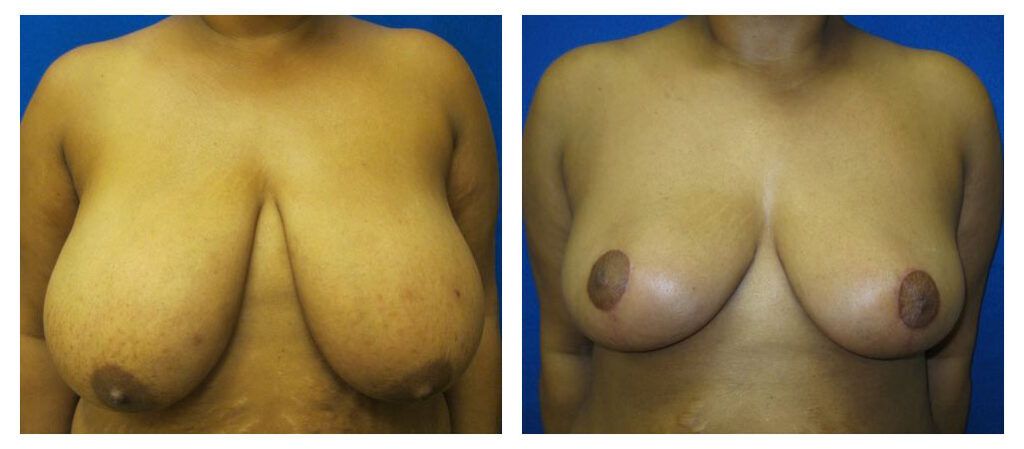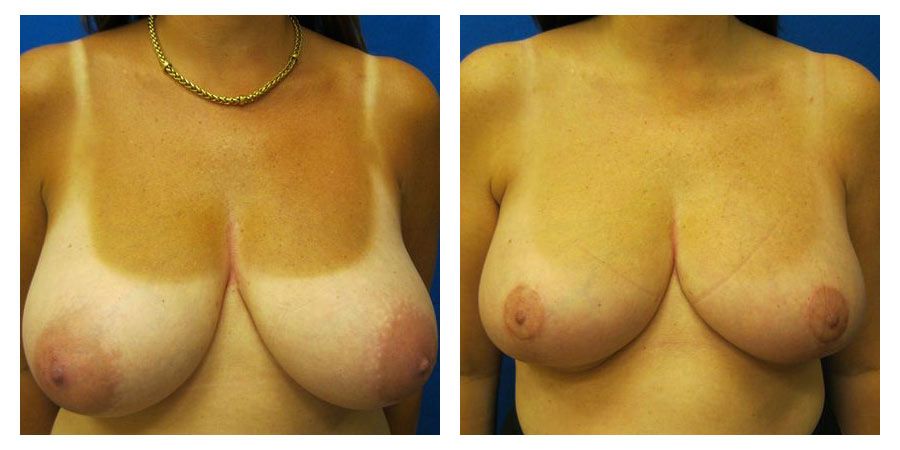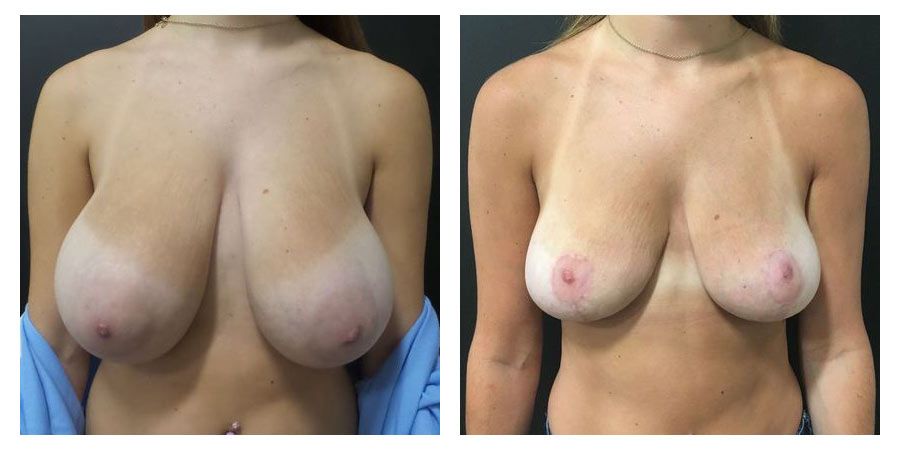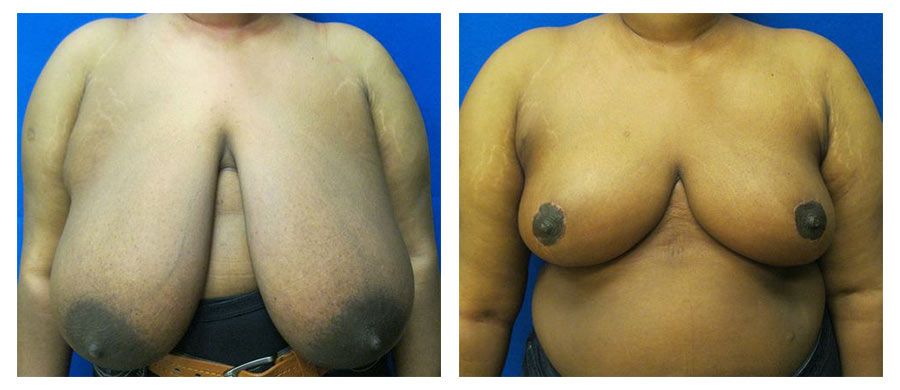Start with our original Breast Reduction Overview Series
Introduction: Relief Is Possible — and Often Covered
If you’ve been living with neck, shoulder, or back pain, deep bra strap grooves, or rashes beneath your breasts, you’re not alone. Thousands of women experience the same symptoms caused by overly large breasts — and many don’t realize that breast reduction surgery is covered by medical insurance when those symptoms are documented.
At Jandali Plastic Surgery in Trumbull, CT, Dr. Shareef Jandali, a board-certified plastic surgeon who performs over 100 breast reductions each year, helps women across Fairfield County and southern Connecticut navigate the insurance process step-by-step.
This guide explains how coverage works, what documentation you’ll need, and how our office makes approval straightforward and stress-free.
Visit our Before and After Breast Reduction Gallery


Why Insurance Covers Breast Reduction
Insurance companies consider breast reduction medically necessary when the size and weight of the breasts cause physical symptoms or functional problems.
Common qualifying symptoms include:
- Chronic back, neck, or shoulder pain
- Painful shoulder grooves from bra straps
- Chronic skin rashes or fungal infections under the breasts
- Poor posture or spinal strain
- Nerve compression or numbness in shoulders or arms
- Difficulty exercising, sleeping, or performing daily activities
When these problems are properly documented, insurance companies recognize that reducing breast size is not cosmetic — it’s therapeutic.
“I had years of back and shoulder pain. I never realized insurance could cover it until Dr. Jandali’s team helped me through the process.” — A.F., Fairfield, CT
Which Insurance Plans Cover Breast Reduction
Most major plans offer coverage when medical criteria are met, including:
- Aetna
- Anthem Blue Cross Blue Shield
- Cigna
- ConnectiCare
- UnitedHealthcare
- Harvard Pilgrim
- Oxford Health Plans
Coverage depends on your individual policy. Our office verifies benefits during your consultation and guides you through preauthorization.
How We Help You Get Insurance Approval
Dr. Jandali and his staff have extensive experience working directly with insurance carriers. Our process is designed to eliminate confusion and maximize your chance of approval.
Step 1: Consultation and Documentation
During your consultation, Dr. Jandali documents your symptoms and physical findings, including:
- Breast size and weight distribution
- Grooves in shoulders from bra straps
- Rash or irritation under the breasts
- Posture and spinal curvature
- Functional limitations (exercise, daily tasks)
Step 2: Medical Photography
We take standardized photos for submission — required by most insurers to document the degree of hypertrophy (breast enlargement).
Step 3: Medical Necessity Letter
Dr. Jandali writes a detailed letter describing:
- Your physical symptoms
- Medical findings
- Estimated breast tissue to be removed
- Failed conservative treatments (support bras, weight loss, physical therapy)
Step 4: Preauthorization Submission
Our team submits all materials — including photos, notes, and the letter — to your insurance company for preauthorization.
Step 5: Appeals (if necessary)
If coverage is initially denied, our team handles the appeal and provides any additional documentation needed.
“The staff handled everything with my insurance company. I didn’t have to make a single phone call.” — J.M., Milford, CT
What Insurance Typically Requires
While every carrier’s criteria differ slightly, most follow similar standards:
1. Documented Symptoms
Chronic pain, rashes, or shoulder grooving must be clearly noted by your surgeon or primary care doctor.
2. Duration of Symptoms
Most insurers want to see symptoms that have persisted for at least 6–12 months, despite conservative measures.
3. Conservative Treatments Attempted
You may need to show you’ve tried:
- Supportive bras
- Physical therapy or posture exercises
- Weight loss efforts
- Anti-inflammatory medication
4. Estimated Tissue Removal
Some carriers use a minimum weight requirement for tissue removal (often based on your height and weight using the Schnur scale).
However, Dr. Jandali emphasizes functional symptoms over arbitrary numbers, and many insurers approve based on clinical need rather than weight thresholds.
When Insurance Covers One Side — and What Happens Next
If you have one breast significantly larger than the other (breast asymmetry), insurance may cover reduction of the larger breast for medical reasons.
The smaller breast may be lifted or slightly reduced for symmetry — often approved within the same authorization.
Dr. Jandali routinely performs these balancing procedures with excellent symmetry and natural results.
What’s Not Covered by Insurance
Insurance typically does not cover purely cosmetic goals, such as:
- Minor lifts without physical symptoms
- Enhancing breast shape for aesthetic reasons
- Adding implants or fat grafting for volume
However, combining a medically necessary reduction with minor aesthetic adjustments is possible — patients often choose to pay only for the cosmetic portion while insurance covers the functional surgery.
How to Prepare for Your Insurance Consultation
To speed up the process, bring the following to your appointment:
- Insurance card and photo ID
- Notes from your primary care doctor, OB/GYN, or chiropractor documenting pain
- List of conservative treatments tried
- Photos (if available) showing rashes or grooving
- Record of physical therapy or dermatologist visits
What If My Insurance Denies Coverage?
Don’t give up — many denials are overturned after appeal.
Common reasons for denial:
- Lack of documentation
- Insufficient symptom history
- Missing physician notes or conservative-treatment proof
At Jandali Plastic Surgery, our staff has successfully appealed countless denials by providing detailed medical records, additional photography, and letters of support.
“My first insurance request was denied by another office. Dr. Jandali’s team resubmitted everything — and it was approved within two weeks.” — E.B., Westport, CT
Breast Reduction Still Covered After Pregnancy or Weight Loss
Insurance still applies even if your breast size or discomfort developed after pregnancy, menopause, or GLP-1 weight-loss medications (Ozempic, Wegovy, Mounjaro).
If symptoms persist — like pain, rashes, or posture problems — coverage criteria are the same.
Dr. Jandali specializes in post-pregnancy and post-weight-loss breast reductions, achieving both medical relief and natural shaping.
What to Expect After Approval
Once approved, our office schedules your surgery at one of our Yale-affiliated facilities:
- Bridgeport Hospital
- Park Avenue Medical Center (ASC)
You’ll receive pre-op instructions, post-op care details, and full cost transparency.
For most patients, insurance covers:
- Surgeon’s fees
- Operating room and anesthesia fees
- Pre-op and post-op visits
Common Questions
Will my insurance cover a breast lift?
Not usually, unless it’s performed as part of a medically necessary reduction.
Do I need a referral?
Some plans require one from your primary care physician — we’ll verify that for you.
Can I choose my breast size?
Dr. Jandali balances your medical needs and aesthetic goals, aiming for a lighter, proportional, and natural result.
Can older women qualify?
Absolutely. Insurance coverage depends on symptoms — not age.
Will my results last?
Yes, especially when maintaining stable weight. Breasts age naturally but remain smaller, lighter, and more comfortable long term.
The Emotional Benefits of Insurance-Covered Breast Reduction
Beyond physical relief, patients often experience life-changing improvements in confidence and activity level:
“I can finally work out, sleep comfortably, and wear fitted tops again. I feel like myself for the first time in years.” — C.C., Norwalk, CT
“I was embarrassed to even ask my doctor for a referral. Now I’m pain-free, and my insurance covered the whole thing.” — K.L., Stratford, CT
Why Choose Dr. Shareef Jandali
- Board-Certified Plastic Surgeon with over 15 years of experience
- Performs 100+ breast reductions annually
- Hundreds of 5-star Google reviews
- Operates at Bridgeport Hospital and Park Avenue Medical Center (Yale-affiliated ASC)
- Proven track record of successful insurance approvals
- Special expertise in post-pregnancy and post-weight-loss breast reduction
“Dr. Jandali is the most thorough and compassionate surgeon I’ve met. His team made the process easy — and my results are perfect.” — R.M., Shelton, CT
Serving Patients Across Fairfield County and Southern Connecticut
We help patients from Trumbull, Fairfield, Bridgeport, Stratford, Milford, Shelton, Norwalk, Westport, Weston, Wilton, Easton, Monroe, Derby, Ansonia, Seymour, Oxford, Newtown, Bethel, and Southbury obtain insurance-covered breast reduction surgery.
Many also travel from Stamford, Greenwich, and New Haven County for our insurance expertise and surgical results.
Call to Action
If large breasts are causing pain, discomfort, or daily limitations, you may qualify for an insurance-covered breast reduction.
Schedule a consultation with Dr. Shareef Jandali to learn exactly what documentation is required and take the first step toward comfort and confidence.
Jandali Plastic Surgery
5520 Park Ave, Suite WP-2-300, Trumbull, CT 06611
203-374-0310
Related Articles in the Advanced Breast Reduction Series
- Scars After Breast Reduction — How We Minimize, Heal, and Refine Them
- Teen Breast Reduction: Safety, Confidence, and Insurance Coverage
- Recovery Timeline After Breast Reduction Surgery
- Post-Pregnancy & Post-Weight-Loss Breast Reduction (Ozempic, Wegovy, Mounjaro)
- Breast Reduction vs. Breast Lift — Which Is Right for You?
- Breast Reduction After Prior Augmentation
- Breast Reduction for Older Women — Comfort, Posture, and Confidence
- Combining Breast Reduction with Liposuction — Enhanced Contour & Shape
- Breast Reduction and Asymmetry Correction
- Insurance-Covered Breast Reduction in Connecticut — What to Know
- Breast Reduction for Athletes
- Breast Reduction and Mental Health
- Breast Reduction and Back, Neck, and Shoulder Pain
- The Jandali Advantage — Why Experience and Volume Matter
- Breast Reduction and Bra Fitting After Surgery
- Revision Breast Reduction Surgery
- Nipple & Areola Shaping, Reduction, and Free Nipple Grafts
- Myths and Misconceptions About Breast Reduction Surgery
- Choosing the Right Size After Breast Reduction







